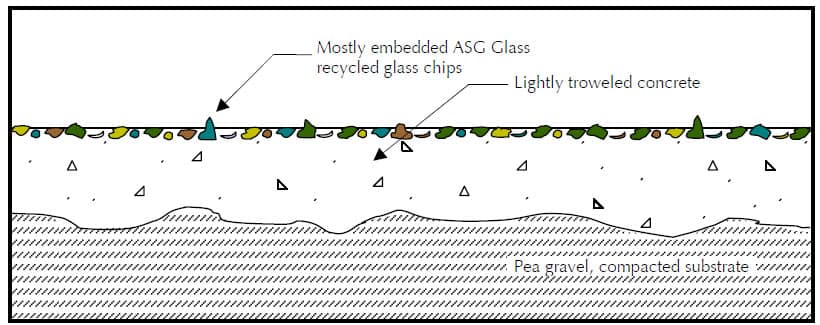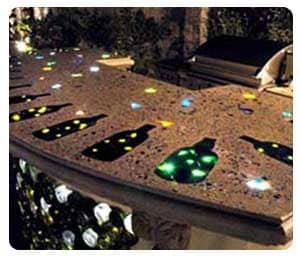Artisan-crafted, decorative concrete or terrazzo countertops are growing in popularity because each creation is unique and a masterpiece of design. Glass aggregate introduces a third dimension to the surface that plays off of light and color, creating a richness and depth worthy of its glorious shine.
This article will explore techniques for embedding glass into these countertops, from seeding to direct mixing, to achieve aesthetic beauty and functional durability.
Seeding Glass for Countertops
Seeding is among the most effective applications for creating unique and colorful countertops. In this method, sprinkle, broadcast, or spread glass chips onto the surface of the concrete countertop. (You may also use this application on a floor, slab, or other surface.)
Even though it can be tricky to spread the glass uniformly onto the surface, artisans can use this technique to create customized, personalized, or one-of-a-kind glass designs using less glass than other types of applications.
Seeding in Seven Steps
- Prepare and place your concrete as you usually do.
- Bull float the concrete to smooth out the surface, but don’t rough trowel or finish trowel your project.
- Spread the glass evenly – or in a pattern – on your concrete surface using any quantity, colors, and glass mixes you desire.
- Lightly trowel the glass into the still-wet concrete, gently pushing the glass into the surface. Don’t push the glass too far in; your finishing, grinding, and polishing process will take longer. For a bolder finish, leave Pea gravel, compacted substrate, and even higher glass tips on the surface or sticking out of the concrete.
- Cure concrete for about seven days, which is enough time to avoid damaging the surface by finishing too early or damaging your tools by completing too late.
- Begin grinding the concrete surface with a 50-grit diamond grinding pad. Increase to 100 grit, then 200 grit, and continue increasing the grit until you achieve the finish and polish you want. Avoid scratching or scarring the concrete by wetting the surface during the grinding process to reduce friction between the pad and the concrete.
- Sweep, vacuum, or wash the surface (often with muriatic acid) to remove dust. Apply a sealer of your choice, carefully following the manufacturer’s recommendations.
Can You Add Glass to Concrete Countertops?
Adding glass to concrete countertops enhances their aesthetic appeal and allows for a wide range of creative designs. The choice of glass – colored, clear, or crushed – can significantly influence the countertop’s appearance, imbuing it with vibrant colors or subtle elegance.
Artisans can strategically place glass pieces to create intricate patterns and thematic designs or replicate natural scenes like seascapes or landscapes. This versatility makes glass popular for those seeking a personalized touch in their kitchen or workspace.
What Are the Disadvantages of Glass Countertops?
While glass countertops are visually appealing, they do come with some drawbacks. The surface can be more prone to scratches and chips than pure concrete countertops. This tendency requires careful use and regular maintenance, including periodic sealing to prevent bacteria growth in the crevices around the glass.
Cleaning these countertops requires specific techniques to avoid damaging the glass. Additionally, the long-term durability of glass countertops may differ from other materials, impacting their lifespan and cost-effectiveness.
Are Concrete Countertops Cheaper?
Concrete countertops can be more cost-effective than traditional materials like granite or marble. This cost savings is particularly true for those who opt for DIY installation, which can significantly reduce labor costs.
The overall expense, however, varies depending on design complexity and the type of glass used. While basic concrete countertops might be more affordable, adding elaborate glass designs or high-end recycled glass can increase the cost.
In addition, factors like maintenance costs and longevity should be considered when comparing concrete countertops with other materials.
Adding Glass to Concrete Countertops
Incorporating glass into concrete countertops is a process that involves careful planning and execution. Choosing the right type of glass is crucial.
For example, larger, colored glass pieces can create a bold statement, while smaller, clear pieces might offer a subtle shimmer.
The method of embedding glass – whether mixed directly into the concrete or seeded on the surface – determines the final look. Seeding allows for more precise placement and pattern creation, while mixing offers a more uniform distribution of glass. These techniques can transform a standard countertop into a visually striking and unique piece of art.
Recycled Glass and Concrete Countertops
Using recycled glass in concrete countertops is an environmentally friendly choice that adds a unique aesthetic appeal. The varied colors and textures of recycled glass can create stunning mosaic effects, making each countertop distinct.
Incorporating recycled glass aligns with sustainable building practices and can sometimes contribute to LEED certification.
Sourcing recycled glass from local suppliers can reduce the environmental impact and support the community. Examples of countertops made with recycled glass often showcase the material’s versatility and the possibility for creative expression in eco-friendly design.

When you’re looking for quality glass chips or decorative concrete countertops, count on Runyon Surface Prep. We carry American Specialty Glass products. ASG recommends adding an acrylic fortifier to the concrete mix to help with the adhesion of the concrete to the glass and other aggregates. Using a retarding product on your concrete surface before spreading the glass chips can also increase the working time.
